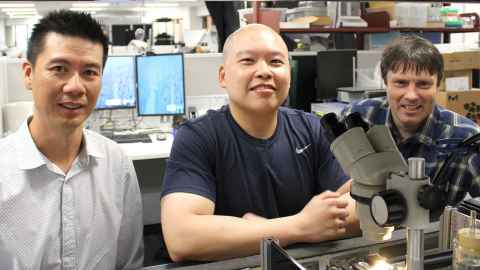Doorways opened for better diabetic heart health
28 September 2022
A puzzle uncovered by researchers from the Auckland Bioengineering Institute (ABI) offers a clue that could lead to a massive change in the lives of people with Type 2 Diabetes.

Dr June-Chiew Han and fellow researchers from Waipapa Taumata Rau University of Auckland are looking closely at cells in diabetic heart muscles using the power of super resolution microscopy. For the first time, scientists have been able to see minute structures of cardiac cells and observe, in fine detail, the behaviour of contractile proteins in early-stage diabetes.
They have found that there are fewer contractile proteins present in the diabetic cardiac cells than in healthy cardiac cells. These specific proteins are integral to the process which tightens heart muscles as part of the heart’s life-sustaining pumping action to move blood around a body.
With specialist equipment designed at ABI, the team also observed the diabetic heart muscle at work. Surprisingly they found that with fewer proteins to elicit a contraction response, the muscle from a diabetic heart maintains the same force as a muscle in a healthy heart.
“With fewer contractile proteins, what we would expect is that force developed would be lower,” says Dr Han. “But this is not the case. What we found is the force developed by the diabetic muscle is the same despite fewer contractile proteins in early-stage diabetes.
“This is a conundrum. We expect that something changes that allows for this force to be maintained.”
They have their suspicions. Data from the team’s pilot study, on heart muscles from rats, suggest a change in one specific protein, the calcium ion release channel known as the ryanodine receptor (RyR). The change of RyR appears to compensate for the contractile function to maintain the force of the muscle. The RyR release channel acts as a doorway inside the cell, controlling the flow of calcium ions inside the cell which triggers the contractile action of the muscle.
“We hypothesise that there will be more of these RyR doorways present in the cardiac cells at early-stage diabetes. So, as more calcium ions come out of the doorways inside the cell and activate more contractile proteins, the force will be preserved.”
New funding of $150,000 from the Heart Foundation will support, over the next two years, further investigation of these doorways in the diabetic heart using heart tissue from rats with a later stage of disease to compare with the earlier stage. Dr Han and colleagues Drs David Crossman, Kenneth Tran and Jarrah Dowrick will investigate how the contractile protein arrangement might be different in a diabetic heart muscle and how that assembly might affect muscle function.
“Diabetes and heart disease go hand in hand as people with Type 2 Diabetes have a high risk for cardiovascular disease and at least a two fold higher rate of death from heart complications. If there really are more RyR doorways, and if we can use a pharmacological intervention that can preserve the many doors, then that will maintain heart contraction function in early-stage diabetes – and help delay that progression of heart disease in diabetes,” Dr Han said.
Media enquiries:
Megan Fowlie
E: megan.fowlie@auckland.ac.nz
M: 022 301 0334